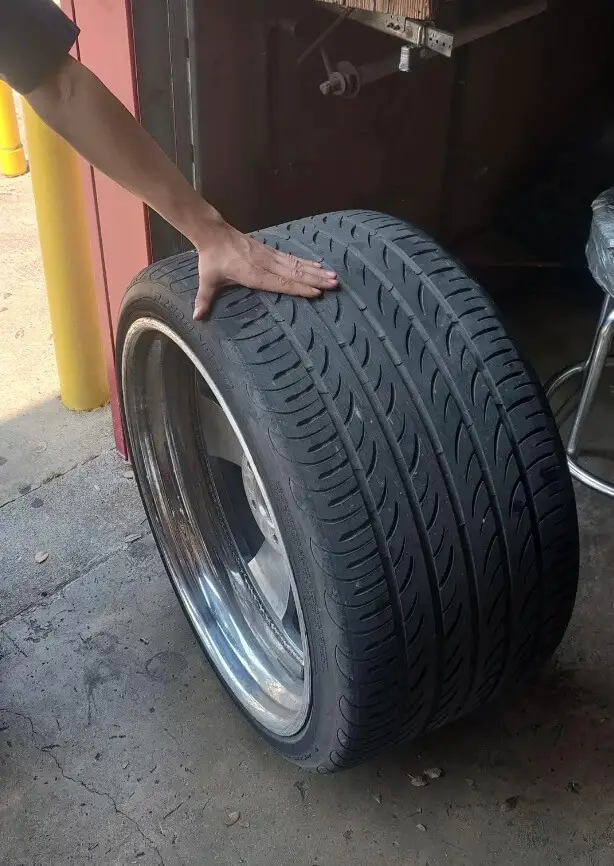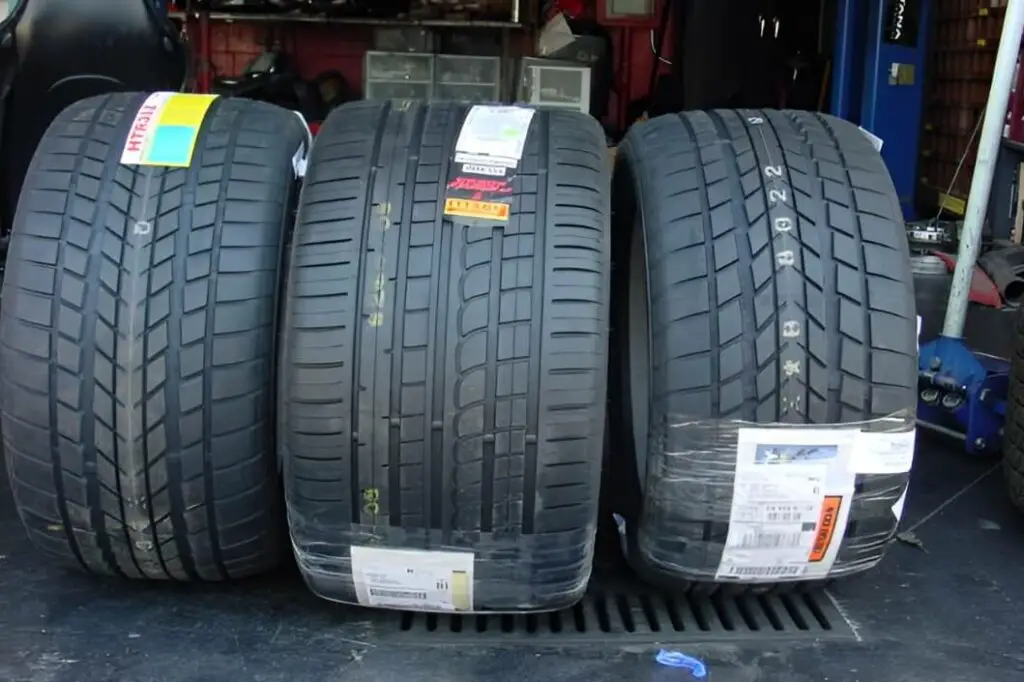Driving in winter weather can be a real challenge, leading many to ask, “Are wider tires better for snow and ice?” It’s an age-old question that we’re going to tackle head-on in this guide.
We’ve navigated the facts, sifted through expert opinions, and even braved the icy conditions ourselves. Strap in and join us on this journey to uncover the truth about tires and winter driving. By the end of this guide, you’ll be well-equipped to take on snowy roads with confidence.
Wider Tires – a topic of debate when it comes to snow driving. Some say they provide better traction and stability on icy roads, while others think narrower tires do better. So, are wide tires better?

Tire grip on snow is key. Wider Tires have a larger contact patch with the road. This gives better traction. The tire can dig into the snow and stay in control when accelerating, braking, and cornering.
But there’s more to consider. Narrower tires can cut through the snow and reach the harder surface below. This gives more pressure and better grip. Plus, the grooves on these tires help channel and remove snow beneath them. This helps maintain a constant grip.
Pro Tip: Tire width isn’t all that matters. Make sure your tires have enough tread depth for safety on winter roads. Check tire pressure and tread wear regularly.
Explanation of Wider Tires
Wider Tires are a popular choice for drivers in snowy conditions. They have a wider tread width than standard tires. This wideness allows more contact with the road and distributes weight more evenly. This gives better grip and control. Plus, the larger surface area pushes through snow and slush.
Plus, they offer flotation on soft snow. The larger footprint stops them from sinking into it. This keeps snow from building up around the tire too. And they absorb bumps and irregularities, giving a smoother ride.
Note: Wider Tires may not be suitable for all vehicles or driving preferences. It’s best to ask a professional tire expert about your needs before buying any.
Must check: Do Bigger Tires Affect Speed? A Comprehensive Guide
Are Wider Tires Better for Snow and Ice?
As temps fall and snow hits the ground, we ask: Are wider tires better for snow and ice? Yes! Wider tires provide greater surface area contact, meaning increased traction on icy surfaces. This is due to a wider footprint, which distributes the vehicle’s weight more evenly. This leads to better handling and less risk of skidding.
Stability on snowy roads also improves with wider tires. The wider width creates a larger base to grip onto, increasing control and preventing the vehicle from swaying. Plus, these tires have unique tread patterns built for snow and ice. The patterns channel away slush and water, boosting grip and reducing hydroplaning. Some are even studded or siped for extra traction.

However, wide tires may not be ideal in all situations. On dry or wet roads, they can have increased rolling resistance and reduced fuel efficiency. To avoid this, swap to regular tires once winter passes.
Advantages of Wider Tires in Snow
Wider tires offer remarkable advantages in snowy conditions. Traction, stability, and control are improved. Weight is distributed evenly, reducing the risk of sinking into the snow. Plus, a larger surface area provides better grip and reduces the chance of slipping. On icy surfaces, braking performance is enhanced, ensuring safer driving.
The advantages of wider tires in snowy conditions include:
- Traction: Wider tires have more surface area in contact with the road, which boosts traction and grip. Vehicle control and stability are maintained.
- Stability: The wider tire width distributes the vehicle weight more evenly. Skidding or sliding is avoided during turns or sudden maneuvers.
- Control: Wider tires improve handling and control on snowy roads. They respond better to steering inputs, making navigation more precise.
- Weight Distribution: The wider tire footprint helps to spread the vehicle’s weight. Sinking or getting stuck is less likely.
- Grip: With a larger contact patch, grip is improved on snowy roads. Acceleration and braking capabilities are enhanced, reducing wheel-spin or sliding.
- Safety: Wide tires offer improved braking on icy surfaces. The wider surface area maximizes contact with the road, enabling quicker stops and reducing accidents.
It is important to note that clearance space within wheel wells and fuel efficiency should be considered when using wider tires. However, their advantages make them a great option for winter driving.

Wider tires gained popularity in the early 1900s, when cars became faster and more powerful. To enhance grip on various surfaces, including snow, wide tires were developed. Tire technology has come a long way since then, making these tires even more effective for maximum traction and stability in snowy conditions.
Disadvantages of Wider Tires in Snow
Wider tires have some serious disadvantages in snowy conditions. They have a large surface area, making them less grippy on slippery surfaces. Also, they can hydroplane with ease. And, they risk getting stuck in deep snow due to their wider footprint.
What’s more, wider tires struggle to cut through snow, making it difficult to maneuver your car. Plus, resistance against the snow decreases the vehicle’s efficiency and increases fuel consumption.
In conclusion, while wider tires may offer some benefits, they should be avoided in snowy conditions. Instead, opt for narrower tires that are designed for snow and ice. These tires provide better traction and control, giving you peace of mind while driving in winter. Upgrade your vehicle’s tires today and enjoy a safe and hassle-free winter driving!
Benefits of Snow Tires
Snow tires offer numerous advantages, like:
- More grip: A special tread pattern and rubber make it easier to control and move on snowy & icy roads.
- Shorter stopping: Snow tires shorten the braking distance on slippery roads. This is important for safety.
- Better performance: They remain flexible even in cold temperatures, ensuring great performance on snow-covered surfaces.
Plus, snow tires have sipes. These are tiny slits in their tread blocks which aid traction by biting into the snow.
Interesting fact: Snow tires were initially created in the early 1900s. They featured metal studs that improved traction on icy surfaces. Due to road damage worries, modern snow tires use other technologies to give better performance in snowy conditions.
You might also like: How Wide is a 385 Tire in Inches: An In-Depth Look
Comparison of Wider Tires and Snow Tires for Snow Conditions
Wider tires and snow tires can both be used while driving in the snow. Let’s explore their differences and how they work.
| Aspect | Wider Tires | Snow Tires |
|---|---|---|
| Traction | Good on dry roads | Excellent on both dry and snowy |
| Handling | Less responsive | More responsive |
| Braking | Longer distance | Shorter distance |
| Price | Generally less expensive | Typically more expensive |
Wider tires have good grip on dry roads. Snow tires offer excellent traction when it’s dry and snowy. Snow tires are also more responsive than wider tires. This can be useful on ice or slippery surfaces. Snow tires also stop quicker than wider tires. That said, wide tires are cheaper than snow tires.
To make a good choice, think about:
- Where you live: If you live in an area with heavy snowfall or icy conditions, invest in specialized snow tires.
- Your driving needs: If you mainly drive on well-maintained roads, wide tires could be a suitable option as they are cheaper and still offer decent traction.
- Tire labeling: Look for the “3PMSF” symbol when choosing snow tires. The 3-Peak Mountain Snowflake symbol shows the tire has met winter performance criteria.
By understanding the differences and considering your location and needs, you can make sure you are safe and perform well in the snow.
Must check: Are Snow Chains Better Than Snow Tires for Winter Traction?
FAQs on Are Wider Tires Better for Snow and Ice:
In the world of automobile maintenance and customization, tire choices can significantly affect vehicle performance. As vehicle enthusiasts and daily drivers alike ponder the impacts of tire width, several questions consistently emerge.
Delving into topics from are wider tires better for snow to understanding the benefits of wider tires in general, this FAQ section sheds light on the intricacies of tire dimensions.
Whether you’re curious about why do wider tires have more grip or if wider winter tires are truly better for snow, we’ve got the answers you seek. Let’s explore these queries and clarify the pros, cons, and realities of wider tire choices:
1. Are wider tires better for driving in snow?
Wider tires can provide better traction and stability on snow-covered roads. They have a larger surface area in contact with the ground, allowing for improved grip. However, it’s important to consider other factors like tread pattern and depth, as well as the vehicle’s weight distribution.
2. Do wider tires help with braking on snowy surfaces?
Wider tires can enhance braking performance on snowy surfaces as they provide better contact and grip. However, braking effectiveness also depends on the tread design and the tire’s ability to expel water and snow from the tread pattern.
3. Are wider tires more prone to hydroplaning on wet snow?
Wider tires are generally not more prone to hydroplaning on wet snow compared to narrower tires. Hydroplaning largely depends on the tread design and the depth of the tire’s grooves, which help channel water away from the contact patch.
4. Do wider tires affect fuel efficiency in snowy conditions?
Wider tires can have a slightly negative impact on fuel efficiency in snowy conditions. The increased surface area in contact with the road creates more rolling resistance, requiring slightly more energy to maintain vehicle movement.
5. Are wider tires suitable for all types of vehicles in the snow?
Wider tires are generally suitable for most vehicles in snowy conditions, but it’s important to consider factors such as clearance, suspension, and weight distribution. Some vehicles, such as sports cars or smaller sedans, may not have enough space for wide tires and could experience handling issues.
6. Are wider tires more expensive for snow use?
Wider tires are often more expensive compared to narrower ones, but the cost difference varies depending on the specific tire brand and model. Additionally, wide tires may wear out faster due to their larger contact patch, potentially leading to more frequent replacements.
Final Thoughts – Are Wide Tires Better for Snow?
It’s clear that wide tires come with many advantages in snowy conditions. The increased surface area and extra grip give more traction and stability for safer journeys on icy and snow-covered roads. Plus, the weight is spread out better, which stops cars sinking into deep snow.
But, it’s important to think about the effect wider tires have on fuel efficiency. They may be better in snowy conditions, but they also have higher rolling resistance. This means vehicles with wider tires tend to be less efficient than those with narrower tires.
Back in the 1970s, during the oil crisis, auto producers made narrower tires to save fuel. Unfortunately, that meant less traction on snow and ice. Over time, technology improved and wider winter tires were created, specifically for snowy regions. They’ve become really popular for people who live in snowy areas.
To sum up, wider tires can be beneficial in snowy situations. They have more surface area, extra grip and help stop cars from sinking. But, fuel efficiency is something to consider. Ultimately, choosing the right tire size all depends on individual preferences and the driving conditions.
Don’t miss out on these related topics: